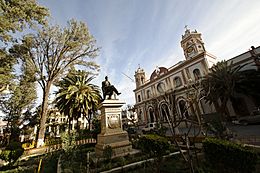Tupiza facts for kids
Quick facts for kids
Tupiza
|
|||
|---|---|---|---|
|
|||
| Country | |||
| Department | Potosi | ||
| Province | Sud Chichas | ||
| Elevation | 2,850 m (9,350 ft) | ||
| Population
(2009)
|
|||
| • Total | 43,100 (2,009) | ||
| Time zone | UTC-4 (BOT) | ||
Tupiza is a city in the Potosí Department of Bolivia. It sits high up, about 2,850 meters (9,350 feet) above sea level. In 2012, about 25,709 people lived there. The area around Tupiza is famous for its amazing red cliffs that rise sharply from the ground. Even though the land is mostly dry and thorny, the Tupiza River brings life, creating green areas for farming. Sometimes, sudden heavy rains can cause quick floods in the valleys nearby.
Tupiza is the main city of the Sud Chichas Province, which is part of the Potosí Department. You can reach Tupiza by bus from Villazón in the south, which connects to Argentina and Tarija. You can also get there by bus from Potosí in the north. A train also runs through Tupiza, following the same route and connecting to mining towns. From Tupiza, it's possible to visit different mining areas and even the famous Salar de Uyuni, a huge salt flat.
Contents
History of Tupiza
The Legend of Butch Cassidy and the Sundance Kid
A famous story says that two well-known outlaws, Butch Cassidy and the Sundance Kid, met their end near Tupiza. They were famous for robbing banks. The legend says the Bolivian army stopped them here. Today, you can take horseback or jeep tours to the places where this event is believed to have happened. It's a popular adventure for visitors!
Climate in Tupiza
Weather Patterns and Seasons
Tupiza has a unique climate because of its high elevation. The weather can change quite a bit between day and night, and also between seasons. Generally, the city experiences warm days and cool nights.
Rainfall and Dry Periods
The city gets most of its rain during the summer months, from December to March. The rest of the year, especially from May to September, is much drier. This is why the area can sometimes have flash floods when heavy rains hit after a long dry spell. The air humidity also changes with the seasons, being higher during the rainy season.
See also
 In Spanish: Tupiza para niños
In Spanish: Tupiza para niños










